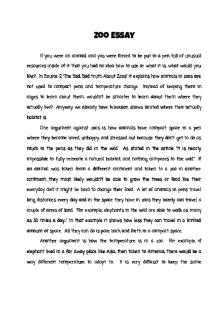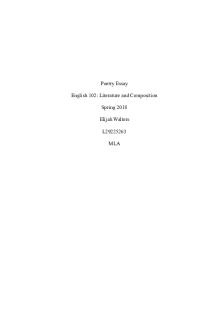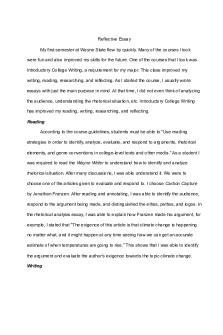Galileo Essay - Grade: B+ PDF

| Title | Galileo Essay - Grade: B+ |
|---|---|
| Author | Stanley Lin |
| Course | Science, Religion, and the Making of the Modern Mind |
| Institution | University of Southern California |
| Pages | 6 |
| File Size | 119.2 KB |
| File Type | |
| Total Downloads | 50 |
| Total Views | 157 |
Summary
The first essay assigned; readings will be extremely helpful here. Professor Zlatan Damjanovic...
Description
Stanley Lin Professor Damjanovic PHIL 256, Section 49458 28 NOV 2018 Galileo’s Mathematical-Experimental Method When thinking of highly influential figures of science, one would find it difficult to discount the contributions of Galileo Galilei, an Italian physicist, astronomer, and philosopher. Born in 1564, Galileo lived in a time in which the status quo of scientific principles were hardly challenged. The status quo in his career as a scientist is Aristotelian physics, which Galileo ultimately challenges through innovating the meaning of science. One of Galileo’s most notable achievements is the development of his mathematical-experimental method, which is why he is sometimes called the “father of the scientific method” or the “father of modern science.” It is this method that the current scientific method is essentially derived from. In addition, this method that assisted Galileo in proving the Copernican heliocentric orientation of the solar system, developing a new theory of motion, as well as disproving Aristotelian physics, an institution that stood for over a thousand years. Through using his mathematical-experimental method, Galileo advanced intellectual understanding of the physics of our world, and enabled future scientists to continue to advance science in a progressive direction of discovery. Galileo’s mathematical-experimental method consists of three steps. The first of which is isolating features of observed phenomena that are measurable. To isolate the measurable features of phenomena is to study solely the quantifiable characteristics of the situation. In many cases, this requires an observer to translate the scenario into mathematics by using equations.
The second step is conceiving of these features as numerically determined in the context of pure mathematics. For example, instead of observing an object moving in space, one may think of that object as a point changing its position in an abstract mathematical state of Euclidean geometry. This construction of an artificial situation allows observers to quantify change. Finally, the third step is formulating these mathematical laws and constructing observable experiments to test if the situations follow the mathematics. Once these mathematical laws are determined to be true, one can relate them back to the physical objects and situation originally observed. The premise of this method is that observational data is not reliable. What one observes may merely be a reflection of the limitations of sensory organs or indicators of the facts of a case. Although this premise starkly resembles Plato’s premise on what true Knowledge is, Galileo did not arrive at this conclusion due to philosophical dogma. He arrived at this conclusion as a result of his experience using a telescope to observe astronomical bodies in the night sky. He noted that through using a tool, his observational data drastically changed compared to observational data gathered only by using the eyes. Since his telescope magnifies observed objects, Galileo determined that his observational data gathered by using his telescope is more accurate than the data gathered by most observers using their eyes. This proves that just by having observational data is not indicative of the truth in any scenario. Using this mindset, Galileo was able to develop a new theory of motion that diverged from and ultimately refuted the established institution of Aristotelian physics. According to Aristotelian physics, there are five elements of which everything in the universe is composed of: earth, water, air, fire, and aether. These elements have different weights, with earth being the heaviest and aether being the lightest. The heaviest material will
naturally move toward the center of the universe while the lightest will float to the edges of the celestial sphere. Thus, celestial bodies are made of aether. In addition, free falling objects travel toward the center of the earth at a constant speed proportional to its weight. This theory of motion provides for a geocentric model of the universe proposed by Ptolemy in the second century AD since earth is the element that is the heaviest, thus the world it creates is at the center of the universe while the stars are made of aether. This became the established scientific understanding of motion and the universe for over a thousand years and remained largely unchallenged. Polish astronomer Nicolaus Copernicus was one of the most relative scientific figure to offer a feasible rebuttal to Aristotelean astronomy in the form of a heliocentric model of the universe. Using the same observational data that Aristotelian astronomers used, Copernicus offered an orientation of the solar system that orbits around the sun in order to account for the calendrical shortcomings of a geocentric orientation of the solar system. Sadly, the Copernican theory of a heliocentric orientation of the solar system became buried in light of religious strife between the Catholic Church and the Protestants, which both denounced the theory for being heretical. Copernicus’ theory did not make its way into mainstream science until hundreds of years after its conception. The new theory of motion that Galileo developed helped him contribute to proving Copernicus’ theory of a heliocentric solar system. Galileo observed that two objects of the same material, one larger than the other, would land at the same time if dropped from the same height. This observation refutes two pillars of Aristotelian physics: the velocity of falling objects is proportional to its weight and that a falling object’s speed is constant. By this logic, the object with more mass should hit the ground first; a ten pound object will hit the ground ten times faster than a one pound object. However, as Galileo discovered, objects during freefall fall
at the same rate of acceleration. Ignoring air resistance by creating an environment inside a vacuum, falling objects made of the same material will always land at the same time, no matter their differences in size. Galileo arrived at this conclusion through the use of experimentation and mathematics. He started with a thought experiment: ignoring air resistance, if a cannon ball and a musket ball were dropped from a tower at the same time, which would land first? He hypothesized that both would land at exactly the same time due to the objects having the same downward acceleration due to gravity. He also assumed that objects rolling down an inclined plane creates a similar situation because freefall is essentially a vertical ramp. To prove this, he devised an experiment which he recounts in his book, Two New Sciences: “ A piece of wooden moulding or scantling, about 12 cubits long, half a cubit wide, and three finger-breadths thick, was taken; on its edge was cut a channel a little more than one finger in breadth; having made this groove very straight, smooth, and polished, and having lined it with parchment, also as smooth and polished as possible, we rolled along it a hard, smooth, and very round bronze ball” (Galilei 178). He repeated this process for several inclinations and distances and always found that the “spaces traversed [by the ball] were to each other as the squares of the times, and this was true for all inclinations of the plane” (Galilei 178). To measure time, Galileo used a water clock. A large container of water with a thin pipe soldered to the bottom was placed above a small glass. The water was allowed to drip into the glass during the duration of each repetition of the experiment. To determine the amount of time that elapsed, the water in the glass was weighed on a balance. To mitigate discrepancies in results of this method of timing, Galileo repeated this experiment many times (Galilei 178). Thus, Galileo proved the Aristotelian theory of motion wrong in that
falling objects did not have constant speed based on weight, but rather, constant acceleration due to gravity. By extension of Galileo’s disproving of the Aristotelian theory of motion, he also suggested that the geocentric model, which Aristotle applied his theory of motion to, was incorrect. Galileo designed his own telescope to assist his astronomical studies; he used it to observe celestial bodies at a magnification. What he found was that Aristotelian objections to Copernicus were wrong. In dealing with the objection that Copernicus lacked observational data to substantiate his theory, Galileo provided two key points. According to Aristotelian astronomers, celestial motion is assumed to only exist if celestial bodies revolved around the Earth. Galileo’s discovery of Jupiter’s four largest moons and observations of Venus run directly in contradiction to this assumption. Galileo discovered four of Jupiter’s largest moons while observing the planet through his telescope, which shows that celestial motion is does not necessarily have to revolve around the Earth. Galileo, while studying Venus, realized that Venus followed similar phases that the moon follows. However, in order for Venus to follow such phases, it may only do so if it orbits the sun because if it were truly orbiting Earth, only two phases would be able to be observed instead of all four. Either the sun or the Earth would obstruct a line of sight between Venus and observers on Earth. The nature of celestial motion is determined by Galileo’s observation to not be geocentric at all. This gives merit to Copernicus’ heliocentric theory, which means that the Aristotelian element of earth need not move toward earth, but toward the sun. In dealing with another major objection of the Copernican model, Galileo offered an experiment on free fall as evidence. This objection was that with a moving Earth, free falling
objects would not fall at the base of where they were dropped; they would be swept away by the motion of the Earth, which according to Copernicus was 107,000 kilometers an hour. Galileo presents a scenario: if one drops an object off of the top of the mast of a ship, it would land at the base of the mast whether the ship is moving or not. Observers on the ship cannot possibly discern if the ship is moving just from this evidence alone because the object will be falling straight down in both situations. An observer on land will be able to note that when the ship is at rest, the object fell straight down, but when the ship is in motion, it would appear to fall in a parabolic motion as illustrated below using a model train and a ball launcher.
Ultimately, Galileo’s work played a major role in the development of the scientific method, physics, and astronomy we know today. Although his work was not enough to prove the Copernican heliocentric model of the universe, his studies, experiments, and observations assisted his contemporaries in their attempts to prove the heliocentric model. Galileo’s influence persevered, despite attempts by the Catholic Church to discredit him, and went on to set the direction of science as we know it today. These are the reasons why we know Galileo as a great figure in scientific history....
Similar Free PDFs

Galileo Essay - Grade: B+
- 6 Pages

Rogerian Essay - Grade: B
- 2 Pages

Zoo Essay - Grade: B+
- 2 Pages

Causation Essay - Grade: B
- 4 Pages

Final Essay - Grade: B+
- 12 Pages

Propaganda Essay - Grade: b
- 4 Pages

Poetry Essay - Grade: B
- 5 Pages

Fiction Essay - Grade: B
- 7 Pages

EPQ Essay - Grade: B+
- 10 Pages

Law essay - Grade: B
- 9 Pages

Persuasive Essay - Grade: B
- 3 Pages

Evicted Essay - Grade: B+
- 3 Pages

Charities essay - Grade: B+
- 13 Pages

Reflective Essay - Grade: B
- 4 Pages

Analysis essay - Grade: B+
- 3 Pages

PACI103 Essay - Grade: B
- 5 Pages
Popular Institutions
- Tinajero National High School - Annex
- Politeknik Caltex Riau
- Yokohama City University
- SGT University
- University of Al-Qadisiyah
- Divine Word College of Vigan
- Techniek College Rotterdam
- Universidade de Santiago
- Universiti Teknologi MARA Cawangan Johor Kampus Pasir Gudang
- Poltekkes Kemenkes Yogyakarta
- Baguio City National High School
- Colegio san marcos
- preparatoria uno
- Centro de Bachillerato Tecnológico Industrial y de Servicios No. 107
- Dalian Maritime University
- Quang Trung Secondary School
- Colegio Tecnológico en Informática
- Corporación Regional de Educación Superior
- Grupo CEDVA
- Dar Al Uloom University
- Centro de Estudios Preuniversitarios de la Universidad Nacional de Ingeniería
- 上智大学
- Aakash International School, Nuna Majara
- San Felipe Neri Catholic School
- Kang Chiao International School - New Taipei City
- Misamis Occidental National High School
- Institución Educativa Escuela Normal Juan Ladrilleros
- Kolehiyo ng Pantukan
- Batanes State College
- Instituto Continental
- Sekolah Menengah Kejuruan Kesehatan Kaltara (Tarakan)
- Colegio de La Inmaculada Concepcion - Cebu